[English] 日本語
 Yorodumi
Yorodumi- PDB-7wrl: Local structure of BD55-1239 Fab and SARS-COV2 Omicron RBD complex -
+ Open data
Open data
- Basic information
Basic information
| Entry | Database: PDB / ID: 7wrl | |||||||||||||||||||||||||||||||||
|---|---|---|---|---|---|---|---|---|---|---|---|---|---|---|---|---|---|---|---|---|---|---|---|---|---|---|---|---|---|---|---|---|---|---|
| Title | Local structure of BD55-1239 Fab and SARS-COV2 Omicron RBD complex | |||||||||||||||||||||||||||||||||
 Components Components |
| |||||||||||||||||||||||||||||||||
 Keywords Keywords | VIRAL PROTEIN / SARS-COV2 Omicron | |||||||||||||||||||||||||||||||||
| Function / homology |  Function and homology information Function and homology informationsymbiont-mediated disruption of host tissue / Maturation of spike protein / Translation of Structural Proteins / Virion Assembly and Release / host cell surface / host extracellular space / viral translation / symbiont-mediated-mediated suppression of host tetherin activity / Induction of Cell-Cell Fusion / structural constituent of virion ...symbiont-mediated disruption of host tissue / Maturation of spike protein / Translation of Structural Proteins / Virion Assembly and Release / host cell surface / host extracellular space / viral translation / symbiont-mediated-mediated suppression of host tetherin activity / Induction of Cell-Cell Fusion / structural constituent of virion / membrane fusion / entry receptor-mediated virion attachment to host cell / Attachment and Entry / host cell endoplasmic reticulum-Golgi intermediate compartment membrane / positive regulation of viral entry into host cell / receptor-mediated virion attachment to host cell / host cell surface receptor binding / symbiont-mediated suppression of host innate immune response / receptor ligand activity / endocytosis involved in viral entry into host cell / fusion of virus membrane with host plasma membrane / fusion of virus membrane with host endosome membrane / viral envelope / symbiont entry into host cell / virion attachment to host cell / SARS-CoV-2 activates/modulates innate and adaptive immune responses / host cell plasma membrane / virion membrane / identical protein binding / membrane / plasma membrane Similarity search - Function | |||||||||||||||||||||||||||||||||
| Biological species |  SARS coronavirus B012 SARS coronavirus B012 | |||||||||||||||||||||||||||||||||
| Method | ELECTRON MICROSCOPY / single particle reconstruction / cryo EM / Resolution: 3.51 Å | |||||||||||||||||||||||||||||||||
 Authors Authors | Zhang, Z.Z. / Xiao, J.J. | |||||||||||||||||||||||||||||||||
| Funding support |  China, 1items China, 1items
| |||||||||||||||||||||||||||||||||
 Citation Citation |  Journal: Nature / Year: 2022 Journal: Nature / Year: 2022Title: BA.2.12.1, BA.4 and BA.5 escape antibodies elicited by Omicron infection. Authors: Yunlong Cao / Ayijiang Yisimayi / Fanchong Jian / Weiliang Song / Tianhe Xiao / Lei Wang / Shuo Du / Jing Wang / Qianqian Li / Xiaosu Chen / Yuanling Yu / Peng Wang / Zhiying Zhang / Pulan ...Authors: Yunlong Cao / Ayijiang Yisimayi / Fanchong Jian / Weiliang Song / Tianhe Xiao / Lei Wang / Shuo Du / Jing Wang / Qianqian Li / Xiaosu Chen / Yuanling Yu / Peng Wang / Zhiying Zhang / Pulan Liu / Ran An / Xiaohua Hao / Yao Wang / Jing Wang / Rui Feng / Haiyan Sun / Lijuan Zhao / Wen Zhang / Dong Zhao / Jiang Zheng / Lingling Yu / Can Li / Na Zhang / Rui Wang / Xiao Niu / Sijie Yang / Xuetao Song / Yangyang Chai / Ye Hu / Yansong Shi / Linlin Zheng / Zhiqiang Li / Qingqing Gu / Fei Shao / Weijin Huang / Ronghua Jin / Zhongyang Shen / Youchun Wang / Xiangxi Wang / Junyu Xiao / Xiaoliang Sunney Xie /  Abstract: Severe acute respiratory syndrome coronavirus 2 (SARS-CoV-2) Omicron sublineages BA.2.12.1, BA.4 and BA.5 exhibit higher transmissibility than the BA.2 lineage. The receptor binding and immune- ...Severe acute respiratory syndrome coronavirus 2 (SARS-CoV-2) Omicron sublineages BA.2.12.1, BA.4 and BA.5 exhibit higher transmissibility than the BA.2 lineage. The receptor binding and immune-evasion capability of these recently emerged variants require immediate investigation. Here, coupled with structural comparisons of the spike proteins, we show that BA.2.12.1, BA.4 and BA.5 (BA.4 and BA.5 are hereafter referred collectively to as BA.4/BA.5) exhibit similar binding affinities to BA.2 for the angiotensin-converting enzyme 2 (ACE2) receptor. Of note, BA.2.12.1 and BA.4/BA.5 display increased evasion of neutralizing antibodies compared with BA.2 against plasma from triple-vaccinated individuals or from individuals who developed a BA.1 infection after vaccination. To delineate the underlying antibody-evasion mechanism, we determined the escape mutation profiles, epitope distribution and Omicron-neutralization efficiency of 1,640 neutralizing antibodies directed against the receptor-binding domain of the viral spike protein, including 614 antibodies isolated from people who had recovered from BA.1 infection. BA.1 infection after vaccination predominantly recalls humoral immune memory directed against ancestral (hereafter referred to as wild-type (WT)) SARS-CoV-2 spike protein. The resulting elicited antibodies could neutralize both WT SARS-CoV-2 and BA.1 and are enriched on epitopes on spike that do not bind ACE2. However, most of these cross-reactive neutralizing antibodies are evaded by spike mutants L452Q, L452R and F486V. BA.1 infection can also induce new clones of BA.1-specific antibodies that potently neutralize BA.1. Nevertheless, these neutralizing antibodies are largely evaded by BA.2 and BA.4/BA.5 owing to D405N and F486V mutations, and react weakly to pre-Omicron variants, exhibiting narrow neutralization breadths. The therapeutic neutralizing antibodies bebtelovimab and cilgavimab can effectively neutralize BA.2.12.1 and BA.4/BA.5, whereas the S371F, D405N and R408S mutations undermine most broadly sarbecovirus-neutralizing antibodies. Together, our results indicate that Omicron may evolve mutations to evade the humoral immunity elicited by BA.1 infection, suggesting that BA.1-derived vaccine boosters may not achieve broad-spectrum protection against new Omicron variants. | |||||||||||||||||||||||||||||||||
| History |
|
- Structure visualization
Structure visualization
| Structure viewer | Molecule:  Molmil Molmil Jmol/JSmol Jmol/JSmol |
|---|
- Downloads & links
Downloads & links
- Download
Download
| PDBx/mmCIF format |  7wrl.cif.gz 7wrl.cif.gz | 85.5 KB | Display |  PDBx/mmCIF format PDBx/mmCIF format |
|---|---|---|---|---|
| PDB format |  pdb7wrl.ent.gz pdb7wrl.ent.gz | 62.9 KB | Display |  PDB format PDB format |
| PDBx/mmJSON format |  7wrl.json.gz 7wrl.json.gz | Tree view |  PDBx/mmJSON format PDBx/mmJSON format | |
| Others |  Other downloads Other downloads |
-Validation report
| Summary document |  7wrl_validation.pdf.gz 7wrl_validation.pdf.gz | 781.4 KB | Display |  wwPDB validaton report wwPDB validaton report |
|---|---|---|---|---|
| Full document |  7wrl_full_validation.pdf.gz 7wrl_full_validation.pdf.gz | 783.6 KB | Display | |
| Data in XML |  7wrl_validation.xml.gz 7wrl_validation.xml.gz | 18.6 KB | Display | |
| Data in CIF |  7wrl_validation.cif.gz 7wrl_validation.cif.gz | 26.8 KB | Display | |
| Arichive directory |  https://data.pdbj.org/pub/pdb/validation_reports/wr/7wrl https://data.pdbj.org/pub/pdb/validation_reports/wr/7wrl ftp://data.pdbj.org/pub/pdb/validation_reports/wr/7wrl ftp://data.pdbj.org/pub/pdb/validation_reports/wr/7wrl | HTTPS FTP |
-Related structure data
| Related structure data |  32732MC 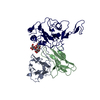 7wr8C 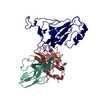 7wroC 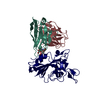 7wrzC  7x6aC  7xiwC 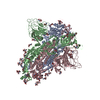 7xixC 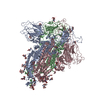 7xiyC 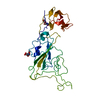 7xizC  7xnqC 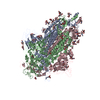 7xnrC 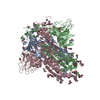 7xnsC M: map data used to model this data C: citing same article ( |
|---|---|
| Similar structure data | Similarity search - Function & homology  F&H Search F&H Search |
- Links
Links
- Assembly
Assembly
| Deposited unit | 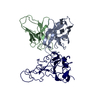
|
|---|---|
| 1 |
|
- Components
Components
| #1: Antibody | Mass: 13828.252 Da / Num. of mol.: 1 Source method: isolated from a genetically manipulated source Source: (gene. exp.)  SARS coronavirus B012 / Production host: SARS coronavirus B012 / Production host:  Homo sapiens (human) Homo sapiens (human) |
|---|---|
| #2: Antibody | Mass: 11049.867 Da / Num. of mol.: 1 Source method: isolated from a genetically manipulated source Source: (gene. exp.)  SARS coronavirus B012 / Production host: SARS coronavirus B012 / Production host:  Homo sapiens (human) Homo sapiens (human) |
| #3: Protein | Mass: 21968.818 Da / Num. of mol.: 1 Source method: isolated from a genetically manipulated source Source: (gene. exp.)  SARS coronavirus B012 / Gene: S, 2 / Production host: SARS coronavirus B012 / Gene: S, 2 / Production host:  Homo sapiens (human) / References: UniProt: P0DTC2 Homo sapiens (human) / References: UniProt: P0DTC2 |
| Has protein modification | Y |
-Experimental details
-Experiment
| Experiment | Method: ELECTRON MICROSCOPY |
|---|---|
| EM experiment | Aggregation state: PARTICLE / 3D reconstruction method: single particle reconstruction |
- Sample preparation
Sample preparation
| Component | Name: Local structure of BD55-1239 Fab and SARS-COV2 Omicron RBD complex Type: COMPLEX / Entity ID: all / Source: RECOMBINANT |
|---|---|
| Source (natural) | Organism:  SARS coronavirus B012 SARS coronavirus B012 |
| Source (recombinant) | Organism:  Homo sapiens (human) Homo sapiens (human) |
| Buffer solution | pH: 8 |
| Specimen | Embedding applied: NO / Shadowing applied: NO / Staining applied: NO / Vitrification applied: YES |
| Vitrification | Cryogen name: OTHER |
- Electron microscopy imaging
Electron microscopy imaging
| Experimental equipment |  Model: Talos Arctica / Image courtesy: FEI Company |
|---|---|
| Microscopy | Model: FEI TALOS ARCTICA |
| Electron gun | Electron source: OTHER / Accelerating voltage: 300 kV / Illumination mode: OTHER |
| Electron lens | Mode: OTHER / Nominal defocus max: 2000 nm / Nominal defocus min: 1000 nm |
| Image recording | Electron dose: 1.07 e/Å2 / Film or detector model: GATAN K3 (6k x 4k) |
- Processing
Processing
| Software | Name: PHENIX / Version: 1.18.2_3874: / Classification: refinement | ||||||||||||||||||||||||
|---|---|---|---|---|---|---|---|---|---|---|---|---|---|---|---|---|---|---|---|---|---|---|---|---|---|
| EM software | Name: PHENIX / Category: model refinement | ||||||||||||||||||||||||
| CTF correction | Type: NONE | ||||||||||||||||||||||||
| 3D reconstruction | Resolution: 3.51 Å / Resolution method: FSC 0.5 CUT-OFF / Num. of particles: 3300 / Symmetry type: POINT | ||||||||||||||||||||||||
| Refine LS restraints |
|
 Movie
Movie Controller
Controller













 PDBj
PDBj




 microscopy
microscopy